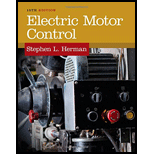
Electric Motor Control
10th Edition
ISBN: 9781133702818
Author: Herman
Publisher: CENGAGE L
expand_more
expand_more
format_list_bulleted
Concept explainers
Question
Chapter 3, Problem 15SQ
To determine
Choose the best option by which the magnetic starter closes the switch.
Expert Solution & Answer
Trending nowThis is a popular solution!

Students have asked these similar questions
Can you solve a question with a drawing
Determine X(w) for the given function shown in Figure (1) by applying the
differentiation property of the Fourier Transform.
Figure (1)
-1
x(t)
An inductor has a current flow of 3 A when connected to a 240 V, 60 Hz power line. The inductor has a wire resistance of 15
Find the Q of the inductor
صورة من s94850121
Chapter 3 Solutions
Electric Motor Control
Ch. 3 - Prob. 1SQCh. 3 - How many poles are required on motor starters for...Ch. 3 - If a motor starter is installed according to...Ch. 3 - Using the time limit overload or the dashpot...Ch. 3 - What causes the AC hum or chatter in AC...Ch. 3 - What is the phase relationship between the flux in...Ch. 3 - In what AC and DC devices is the principle of the...Ch. 3 - What does the electrician look for to remedy the...Ch. 3 - What type of protective enclosure is most commonly...Ch. 3 - What advantage is there in using combination...
Ch. 3 - What safety feature does the combination starter...Ch. 3 - Prob. 12SQCh. 3 - How is the size of the overload heaters selected...Ch. 3 - What type of motor starter enclosure (include NEMA...Ch. 3 - Prob. 15SQCh. 3 - Prob. 16SQCh. 3 - Prob. 17SQCh. 3 - Prob. 18SQCh. 3 - Select the best answer for each of the following....Ch. 3 - Prob. 20SQCh. 3 - Prob. 21SQCh. 3 - Select the best answer for each of the following....Ch. 3 - Prob. 23SQCh. 3 - Select the best answer for each of the following....Ch. 3 - Select the best answer for each of the following....Ch. 3 - Select the best answer for each of the following....Ch. 3 - Select the best answer for each of the following....Ch. 3 - Prob. 28SQCh. 3 - Select the best answer for each of the following....Ch. 3 - Prob. 30SQCh. 3 - Prob. 31SQCh. 3 - What is the difference between a grounded control...Ch. 3 - A control transformer has a primary voltage of 480...
Knowledge Booster
Learn more about
Need a deep-dive on the concept behind this application? Look no further. Learn more about this topic, electrical-engineering and related others by exploring similar questions and additional content below.Similar questions
- The joint density function of two continuous random variables X and Yis: p(x, y) = {Keós (x + y) Find (i) the constant K 0 2 0arrow_forwardShow all the steps please, Solve for the current through R2 if E2 is replaced by a current source of 10mA using superposition theorem. R5=470Ω R2=1000Ω R6=820Ωarrow_forwardPlease solve it by explaining the steps. I am trying to prepare for my exam tomorrow, so any tips and tricks to solve similar problems are highly appreciated. Plus, this is a past exam I am using to prepare.arrow_forwardPlease solve it by explaining the steps. I am trying to prepare for my exam today, so any tips and tricks to solve similar problems are highly appreciated. Plus, this is a past exam I am using to prepare.arrow_forwardIf C is the circle |z|=4 evaluate f f (z)dz for each of the following functions using residue. 1 f(z) = z(z²+6z+4)arrow_forwardIf C is the circle |z|=4 evaluate ff(z)dz for each of the following functions using residue. f(z) z(z²+6z+4)arrow_forwardDetermine X(w) for the given function shown in Figure (1) by applying the differentiation property of the Fourier Transform. 1 x(t) Figure (1) -2 I -1 1 2arrow_forwardPlease solve it by explaining the steps. I am trying to prepare for my exam tomorrow, so any tips and tricks to solve similar problems are highly appreciated. Plus, this is a past exam I am using to prepare.arrow_forwardPlease solve it by explaining the steps. I am trying to prepare for my exam tomorrow, so any tips and tricks to solve similar problems are highly appreciated. Plus, this is a past exam I am using to prepare.arrow_forwardPlease solve it by explaining the steps. I am trying to prepare for my exam tomorrow, so any tips and tricks to solve similar problems are highly appreciated. Plus, this is a past exam I am using to prepare.arrow_forwardPlease solve it by explaining the steps. I am trying to prepare for my exam tomorrow, so any tips and tricks to solve similar problems are highly appreciated. Plus, this is a past exam I am using to prepare.arrow_forwardPlease solve it by explaining the steps. I am trying to prepare for my exam tomorrow, so any tips and tricks to solve similar problems are highly appreciated. Plus, this is a past exam I am using to prepare.arrow_forwardarrow_back_iosSEE MORE QUESTIONSarrow_forward_ios
Recommended textbooks for you
 Electricity for Refrigeration, Heating, and Air C...Mechanical EngineeringISBN:9781337399128Author:Russell E. SmithPublisher:Cengage Learning
Electricity for Refrigeration, Heating, and Air C...Mechanical EngineeringISBN:9781337399128Author:Russell E. SmithPublisher:Cengage Learning Delmar's Standard Textbook Of ElectricityElectrical EngineeringISBN:9781337900348Author:Stephen L. HermanPublisher:Cengage Learning
Delmar's Standard Textbook Of ElectricityElectrical EngineeringISBN:9781337900348Author:Stephen L. HermanPublisher:Cengage Learning

Electricity for Refrigeration, Heating, and Air C...
Mechanical Engineering
ISBN:9781337399128
Author:Russell E. Smith
Publisher:Cengage Learning

Delmar's Standard Textbook Of Electricity
Electrical Engineering
ISBN:9781337900348
Author:Stephen L. Herman
Publisher:Cengage Learning
